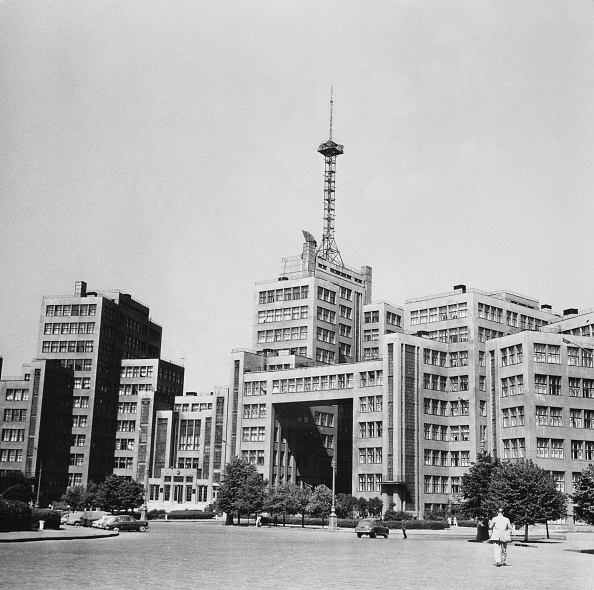by Sonia Kagna
I grew up in a grey rectangular city built by dreamers playing with gigantic concrete blocks. The dreamers imagined a purposeful communal living where workers together would build a glorious future without some negligible material things distracting them on the way. The future-builders would look out of the enormous three-panel windows of their apartments, see and greet each other. They would spend minimal allotted time in their tiny toilets and kitchens conjoined with bathtubs. These were all great dreams of innovators later called “Constructivists”, but these dreams did not belong to the little girl who loved fairy tales. Among the straight austere lines of the wide dusty gray streets, there was no place for dragons, fairies, magicians, and knights in shining armor.

Sporadic dwarfish green bushes and maple and poplar trees that towered over the buildings could possibly provide some temporary hiding places for the magical creatures, but no real place to live since the trees lose all their greenish–then yellowish—and then -brownish leaf-wear by the end of October. In November, people would try to liven up the space by digging up the washed-out, barely red banners with meaningless slogans, and marched up the street to the humongous gray square–where the statue of a chunky bold man stood, pointing with his outstretched hand the way they should go to perform their yearly rituals. The marching crowds that wore drab darkish colors did not believe in magic and dragons, which was funny because they proclaimed that the bold chubby man in bronze was still alive. There was absolutely nothing alive about the statue, except for the pigeons that pooped on it.
When even that semblance of color was gone, and stick figures of naked trees stood among empty rectangular spaces between the gray concrete walls, the miracle finally came. It started with tiny flakes dropping down from the obscured white sky: beautiful six-pointed sparkling treasures reflecting the light with a bluish tinge of the coming evening. They first came as circling single dancers, later congregating into clusters of weightless white fur shed by the magical animals that flew above, disguised as heavy clouds. When this fur covered the grey of the streets with a shimmering crystalline white coat, the city finally started to add its own live colors to the palette: stores put up silver garlands and glimmering ornaments, people put on fur hats bristling with icicles, and flashes of bright knitted scarves, mittens, and shawls appeared among the gray, black, and brown crowd, filling the trolley stops.
Pine trees invaded every home, bringing a sharp, tingling smell of the forest, with a tinge of sap around the edges. Now came the turn of dusty cardboard boxes on top of old wardrobes: they were full of fragile treasures of the New Year ornaments, and each of them had to find an ideal place where it belonged, in its tiny pine cave on the tree: icicles, spheres, animals, soldiers – all needed to melt and mold into the mystery of green needles. Then the lights on the green wire were carefully liberated from their bundles: together with the silverish garlands, they circled around the tree like serpentines, and colorful tinsel “rains” of thinly cut, long foil strips descended from the pines in tiny streams. At the very end, as a final touch, the figurines of Father Frost and his granddaughter Snow Maiden wearing beautiful blue winter coats found their places under the tree, guarding its magical world.
The Holidays brought another miracle: the coming of colorful fairy tales and adventure stories to the local movie theater. The grey house of the movie theater stood across the street. It was another rectangular construction with palatial ground floors housing a grocery store, and a similar building facing a quiet street with big advertisements for upcoming movies. There usually was a bleak blue and black picture of men in military or police uniforms, their faces scrunched up un an effort to project strength, and women with long hair flowing and wide eyes opened in horror.
One day a different picture went up on the wall: a tall tower of a medieval castle dominated the canvass, with a tiny figure in a bright blue flowing cloak climbing up the steep vertical wall. I was passing by, with my mother holding my hand tightly, because I tended to wander. “Can we go see it?” I asked. “Well, if you want to, but it’s really not for children, it’s a love story, and there is fighting in it”. Was there ever a more enticing description for a little lover of fairy tales?
The inside of the movie theater was a white-tiled austere affair with elaborate empire columns, that stood there as unwelcome intruders from a different dimension. An ancient white metal contraption with scratched glass displayed sad-looking wilted ham pieces on dried bread, and a severe-looking, plump lady in a white apron and starched white headpiece was standing behind the contraption like a guard, exchanging large glasses of watered-down juices and coffee for bleak coins that lost their shine a long time ago. We bypassed the lady who gave us an evil eye, and walked into a large dark chamber with high ceilings, rows of worn-down red velvet seats, and a dark burgundy curtain obscuring the stage in front. We settled in one of the front rows, with my mother’s perfume following us like a tiny invisible breeze among the heavy smells of wet winter wool and sweat.
With the curtain pulled open to the sides, the splash of color on the screen washed over us with a wave of uplifting sound. Bright everything: sky, grass, trees, horses, elaborately adorned buildings and interiors, the colors of rich clothes of velvet, silk and lace, the shining of the sun, swords, and diamonds dazzled the eyes. What was the movie about? The plot was not that important: it was about color, energy, feelings, beautiful things, and beautiful people, not the black-and-white semblance of reality that surrounded us on the streets and on TV at home. After the first shock subsided and the images of people became clearer, just one beautiful face dominated the screen. He looked like the white marble statues in the art albums, and in the book about Greek mythology that my grandmother read to me, except he was sparkling with color; he was the most true and real person I had ever seen. He climbed that tower not just to free a lady, but because he fought for a life full of color and truth, not the fake imitation of it.
My mother was not thrilled with my excitement: “He is an actor, Solnyshko (Sunny), and not the best one, if you want me to be honest, he is quite old now, he was older than me when they made this movie.” She went on to explain that the movie was originally made in France and the language was French, so the actors were not speaking with their own voices because the movie was dubbed in the studio. I did not care, the man on the screen embodied honesty and heroism. His world was full of artful shapes, bright silk and deep dark velvet, shimmering blades, and powerful horses. I felt more at home in his reality than among the gray rectangular buildings on gray rectangular streets that surrounded us outside of the movie theatre.

“You don’t get it Mama, he is a true hero, it would be so much better if it was his statue on the Square and not that ugly bold man’s.” Because I already knew that in actual Ancient Greece the marble statues were not white, but painted in the brightest colors of crimson, azure, and real gold, I vividly imagined Jean’s statue (that was the name of the man on the screen) in the middle of the Square, his face and hands painted like he was alive, his strong powerful body wrapped in layers of velvet and gold. He would have been perfect, but would he stay there motionless, or would he just step off the giant podium steps and walk the grey streets, coloring them in his wake? My mother suddenly had a bout of coughing, interspersed with tiny giggles. She looked around worriedly checking if anyone heard us, by that time we were exiting the theatre among the last remnants of the crowd, and then she said to me in a serious voice to never tell that to anyone ever again because I might get her in trouble.
After this movie, it became a tradition in our movie theatre to show Jean’s colorful pictures every year during the Winter Holidays. Jean effortlessly became a part of the world of fairy tales in which my mind found refuge from the bleakness and everyday false reality of late Soviet life. He did not become my idol, hero, or infatuation. His image was too true and honest to fit any of these job descriptions. Jean Marais, a French actor and artist who was born in 1913, earlier that any of my grandparents, became my best and truest imaginary friend. He was inhabiting the realm of endless possibilities, effortlessly shifting his age to become my peer and guide, a boy slightly taller and older than me.
During another Winter Holidays season, I saw Jean on TV (we finally had a color one), at his real age. The chubby smiling director of the most famous Russian Holiday movie was interviewing Jean in France, in his bright beautiful house at the seaside. Personally, I did not like the sad movie called “Irony of Fate” that people in my country religiously watched every year. I thought it was stupid to show something miserable right on New Year’s Eve. If people believe that their whole year would resemble the way they meet its arrival, why in the world would they want it to be about helpless people bemoaning their hopeless existence in indistinguishable cages of identical small apartments–with interchangeable furniture–while singing sad songs. The reason why I was supposed to enjoy this entirely escaped me.
Anyway, it did not matter, the director was interviewing the real Jean. At the beginning I was scared that seeing him old would destroy that youthful image I held so dear to my heart. It did not happen. Quite the opposite: the smiling old man in a bright burgundy red sweater was pulling the chubby director by the strings like a marionette, diverting all questions to what he wanted to say, not the nice polite smooth words that were expected of him. I was in awe of that show of will and freedom of speech, so rare in the world where I lived. Jean was true to his image of a hero who fights for the truth, but he was deeper than that. To my surprise he said that all his heroic colorful movies were pure entertainment, and making money for him. His true art was expressed much earlier in the movies made by his mentor and friend whom he loved and admired, and when that person died, Jean’s heart broke forever.
What followed was the short and fast footage of the scenes of incomparable beauty in black and white. The legend of Tristan and Iseult, the fairy tale of Beauty and the Beast, and the myth of Orpheus and Euridice shot through me like powerful arrows. Jean was changing me as he spoke, molding my perception of beauty and for the first time in my life making me appreciate the simple lines, the nakedness of the monochrome. He forced me to rethink how I perceived my surroundings. I started finding beauty in sharp angles and unadorned straight lines. I walked the streets of my city that eventually revealed itself to be so much deeper and bigger than its wounded and betrayed Constructivist heart, and Jean was at my side uncovering hidden horror stories and secrets of survival.
Fast-forward through my youth into early adulthood, Jean Marais and his maître and lover Jean Cocteau stayed with me and never disappointed. I would learn from Jeannot (“Jean” and “Jeannot” was the way Cocteau distinguished himself from Jean Marais) to not get bitter by the failures, respond to hateful jealous people with kindness, and leave the ill-wishers behind while going forward into the brighter future. I learned from Jean to persevere in the face of unimaginable odds when every single obstacle is against you, like he did when he created one of the greatest world’s cinematic achievements: the original Beauty and the Beast, which made all the countless versions of it just a tiny footnote on its page.
When I was flying across the Ocean to my new home in America, one of the few books I took with me was Jean Marais’ biography and one of the first books that I got in The Strand Bookstore in New York was “Beauty and the Beast: Diary of a Film” by Jean Cocteau. I was going to celebrate my first New Year Eve’s in my new country and was excited about spending time in a cheerful company of young immigrants who spoke my native language. The New Year’s party was sparkling with glitter and bright shimmering garlands. Champaigne and stronger drinks kept coming and filling the glasses. After sitting at the big table, we spread around into smaller groups. I knew only a few people there, so I was excited when a young woman my age gingerly approached me and told me that she was from my home city. We were so happy to find each other: she was from the newer development further down the main avenue from the center, and closer to the park with the stream with fresh artesian water, that had a note of sweetness in its taste.
It turned out that as a girl she was taking a trolley to our movie theater, and for her the movies with Jean Marais were also the treasured memories of her childhood. Since she had no idea about Jean’s earlier works with his mentor, I was eager to share what I knew: the triple role of the Beast, Beauty’s Fiancé, and the Prince, the Eternal Return of Tristan to his Iseult, the image of immortal beauty of Orpheus mirrored through the water puddle, all of it a testament of creative union between two artists who loved and inspired one another.
I was talking and talking and then I suddenly registered the surprising lack of response from my new friend. Her face was scrunched up in an expression of anger and distress, tears were glistening on her cheeks. She looked at me with the intensity of someone who wanted to dig my eyes out. “You! “She heaved, “I am so sorry that I have met you! You are a horrible person with no moral principles, you have no shame and no regard for others’ feelings! You just ruined my New Year celebration. What’s more, you ruined the most precious memories of my childhood!” With these last words she turned sharply away from me, marched up to the host, and with the parting remark: “You should better think of whom to invite to your house next time!” She abruptly left the party.
To say I was surprised would be saying nothing. I was stunned and utterly crushed. It was not just the ruin of my budding friendship that upset me, but the utter rejection of the truth about the artist who brought so much beauty into my life, who taught me to see the world with a wider perspective, dig deep for its hidden treasures of simplicity and complexity. I took my coat and stepped out into the cold. The frosty air calmed me down and cleared my head a little. Barely visible sparse snowflakes shimmered in the light of the lanterns down the street. Unconsciously I reached into my childhood’s source of comfort: I imagined Jean alongside me standing in the light and snow. He appeared as an Orpheus this time, ready to dig me out from the underworld of my loneliness. He turned to me and smiled with his winning powerful smile, bowed, and dissolved into the sparks of snow that suddenly began to fall heavier from the sky.



